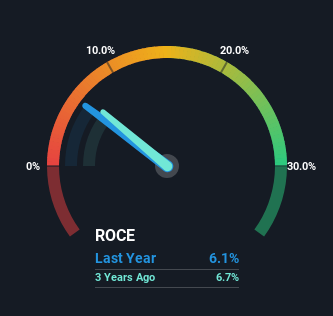- Japan
- /
- Trade Distributors
- /
- TSE:9932
The Returns On Capital At Sugimoto (TSE:9932) Don't Inspire Confidence

What underlying fundamental trends can indicate that a company might be in decline? A business that's potentially in decline often shows two trends, a return on capital employed (ROCE) that's declining, and a base of capital employed that's also declining. Basically the company is earning less on its investments and it is also reducing its total assets. In light of that, from a first glance at Sugimoto (TSE:9932), we've spotted some signs that it could be struggling, so let's investigate.
Return On Capital Employed (ROCE): What Is It?
Just to clarify if you're unsure, ROCE is a metric for evaluating how much pre-tax income (in percentage terms) a company earns on the capital invested in its business. The formula for this calculation on Sugimoto is:
Return on Capital Employed = Earnings Before Interest and Tax (EBIT) ÷ (Total Assets - Current Liabilities)
0.061 = JP¥2.3b ÷ (JP¥42b - JP¥4.6b) (Based on the trailing twelve months to June 2024).
Therefore, Sugimoto has an ROCE of 6.1%. On its own, that's a low figure but it's around the 7.3% average generated by the Trade Distributors industry.
Check out our latest analysis for Sugimoto

Historical performance is a great place to start when researching a stock so above you can see the gauge for Sugimoto's ROCE against it's prior returns. If you'd like to look at how Sugimoto has performed in the past in other metrics, you can view this free graph of Sugimoto's past earnings, revenue and cash flow.
What The Trend Of ROCE Can Tell Us
In terms of Sugimoto's historical ROCE movements, the trend doesn't inspire confidence. About five years ago, returns on capital were 8.9%, however they're now substantially lower than that as we saw above. On top of that, it's worth noting that the amount of capital employed within the business has remained relatively steady. This combination can be indicative of a mature business that still has areas to deploy capital, but the returns received aren't as high due potentially to new competition or smaller margins. So because these trends aren't typically conducive to creating a multi-bagger, we wouldn't hold our breath on Sugimoto becoming one if things continue as they have.
Our Take On Sugimoto's ROCE
All in all, the lower returns from the same amount of capital employed aren't exactly signs of a compounding machine. However the stock has delivered a 88% return to shareholders over the last five years, so investors might be expecting the trends to turn around. In any case, the current underlying trends don't bode well for long term performance so unless they reverse, we'd start looking elsewhere.
If you'd like to know about the risks facing Sugimoto, we've discovered 1 warning sign that you should be aware of.
While Sugimoto may not currently earn the highest returns, we've compiled a list of companies that currently earn more than 25% return on equity. Check out this free list here.
New: Manage All Your Stock Portfolios in One Place
We've created the ultimate portfolio companion for stock investors, and it's free.
• Connect an unlimited number of Portfolios and see your total in one currency
• Be alerted to new Warning Signs or Risks via email or mobile
• Track the Fair Value of your stocks
Have feedback on this article? Concerned about the content? Get in touch with us directly. Alternatively, email editorial-team (at) simplywallst.com.
This article by Simply Wall St is general in nature. We provide commentary based on historical data and analyst forecasts only using an unbiased methodology and our articles are not intended to be financial advice. It does not constitute a recommendation to buy or sell any stock, and does not take account of your objectives, or your financial situation. We aim to bring you long-term focused analysis driven by fundamental data. Note that our analysis may not factor in the latest price-sensitive company announcements or qualitative material. Simply Wall St has no position in any stocks mentioned.
About TSE:9932
Sugimoto
Engages in the sale, import, and export of machinery and equipment in Japan and internationally.
Excellent balance sheet second-rate dividend payer.
Market Insights
Community Narratives




